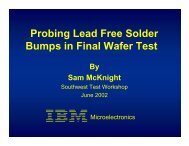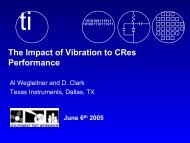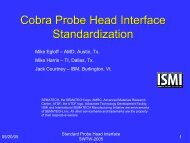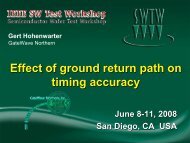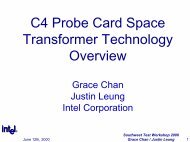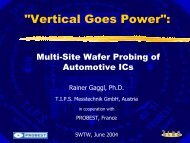MSO â Multi Site Optimizer - Semiconductor Wafer Test Workshop
MSO â Multi Site Optimizer - Semiconductor Wafer Test Workshop
MSO â Multi Site Optimizer - Semiconductor Wafer Test Workshop
You also want an ePaper? Increase the reach of your titles
YUMPU automatically turns print PDFs into web optimized ePapers that Google loves.
Presenter’s Name June 12 to 15, 2011<br />
Company<br />
San Diego, CA<br />
Kevin Fredriksen /<br />
<strong>MSO</strong> – <strong>Multi</strong> <strong>Site</strong> <strong>Optimizer</strong><br />
For IEEE SW <strong>Test</strong> <strong>Workshop</strong><br />
Company<br />
Logo<br />
Kevin Fredriksen, SPA GmbH<br />
Germany<br />
Customer support / Sales
OVERVIEW<br />
<strong>MSO</strong> HISTORY<br />
<strong>MSO</strong> basics and facts<br />
Optimization example<br />
<strong>Multi</strong> site layouts & touchdown options<br />
Stepping path algorithms<br />
MEMS wafer test – a multi site quest!<br />
Summary<br />
June 12 to 15, 2011<br />
IEEE SW <strong>Test</strong> <strong>Workshop</strong> 2
<strong>MSO</strong> HISTORY<br />
Prober<br />
<strong>Multi</strong> site test on prober<br />
<strong>Multi</strong> site test<br />
<strong>Wafer</strong><br />
= NON-OPTIMIZED<br />
touchdown positioning<br />
June 12 to 15, 2011<br />
IEEE SW <strong>Test</strong> <strong>Workshop</strong> 3
<strong>MSO</strong> HISTORY<br />
Prober<br />
<strong>Multi</strong> site test on prober<br />
<strong>Multi</strong> site test<br />
?<br />
<strong>Wafer</strong><br />
= NON-OPTIMIZED<br />
touchdown positioning<br />
June 12 to 15, 2011<br />
IEEE SW <strong>Test</strong> <strong>Workshop</strong> 4
<strong>MSO</strong> HISTORY<br />
MULTI SITE TEST SITUATION<br />
<strong>Multi</strong> site test on prober<br />
Most probers do not supply any<br />
intelligent stepping algorithms<br />
Unnecessary high amount<br />
of touchdowns to process<br />
As a result: long process times<br />
Highlighted fields signalize<br />
potential touchdown<br />
surplus !<br />
June 12 to 15, 2011<br />
IEEE SW <strong>Test</strong> <strong>Workshop</strong> 5
<strong>MSO</strong> HISTORY<br />
Create a program that minimizes<br />
touchdowns by automatic shifting<br />
of touchdown coordinates.<br />
IS-TEST<br />
GmbH<br />
June 12 to 15, 2011<br />
IEEE SW <strong>Test</strong> <strong>Workshop</strong> 6
<strong>MSO</strong> HISTORY<br />
PRIMARY GOAL: minimize<br />
total oa amount of touchdowns<br />
Touchdown<br />
column shift<br />
Optimized touchdown positioning<br />
Touchdown<br />
row shift<br />
Touchdown<br />
surplus/fall-out<br />
after<br />
column/row shift<br />
6 out of 56 touchdowns saved!<br />
June 12 to 15, 2011<br />
IEEE SW <strong>Test</strong> <strong>Workshop</strong> 7
<strong>MSO</strong><br />
Basics and facts<br />
The benefits and usability of <strong>MSO</strong><br />
June 12 to 15, 2011<br />
IEEE SW <strong>Test</strong> <strong>Workshop</strong> 8
INTRODUCTION<br />
The <strong>Multi</strong> <strong>Site</strong> Layout <strong>Optimizer</strong> (<strong>MSO</strong>) is an easy to use<br />
software for optimizing multisite layouts.<br />
The benefits:<br />
<br />
<br />
<br />
Less touchdowns<br />
Optimized probing path<br />
Optimized hot probing<br />
<br />
Find ideal probecard layout<br />
June 12 to 15, 2011<br />
IEEE SW <strong>Test</strong> <strong>Workshop</strong> 9
<strong>MSO</strong> workflow A<br />
+ +<br />
Controlmap Physical wafer <strong>Multi</strong>site probecard<br />
Optimized touchdowns<br />
Optimized stepping<br />
June 12 to 15, 2011<br />
IEEE SW <strong>Test</strong> <strong>Workshop</strong> 10
<strong>MSO</strong> workflow B<br />
+ +<br />
Controlmap Physical wafer <strong>Multi</strong>site params<br />
Ideal multi site<br />
probecard layout<br />
June 12 to 15, 2011<br />
IEEE SW <strong>Test</strong> <strong>Workshop</strong> 11
<strong>MSO</strong><br />
Example<br />
Complete Optimization<br />
Touchdowns and stepping path<br />
June 12 to 15, 2011<br />
IEEE SW <strong>Test</strong> <strong>Workshop</strong> 12
MINIMIZE TOUCHDOWNS<br />
Prober: 44 Tochdowns<br />
<strong>MSO</strong>: 38 Touchdowns<br />
Technology: automatic column / row shift<br />
= 14,6 % TD reduction!<br />
June 12 to 15, 2011<br />
IEEE SW <strong>Test</strong> <strong>Workshop</strong> 13
OPTIMIZE PROBING PATH<br />
Prober stepping: 1680mm<br />
<strong>MSO</strong> stepping: 1056mm<br />
Technology: shortest way<br />
= ~37 % Stepping reduction!<br />
June 12 to 15, 2011<br />
IEEE SW <strong>Test</strong> <strong>Workshop</strong> 14
TEST-COST REDUCTION<br />
<strong>Wafer</strong>type/Prober parameters<br />
Dies to test / <strong>Wafer</strong> = 3.823<br />
<strong>Test</strong> Time / TD = 5sec.<br />
Number of DUT = 128 X/Y Stepping / sec = 100mm<br />
Non-optimizedoptimized<br />
<strong>MSO</strong><br />
Number of TD / <strong>Wafer</strong> 44 TD 38 TD<br />
<strong>Test</strong> time / <strong>Wafer</strong> 220 sec. 190 sec.<br />
X/Y Stepping / <strong>Wafer</strong> 1680 mm 1056 mm<br />
Stepping Time / <strong>Wafer</strong> 17 sec. 11 sec.<br />
Total <strong>Test</strong> Time / <strong>Wafer</strong> 237 sec. 201 sec.<br />
Process time reduction /wafer = 36 sec. = ~15%<br />
TEST COST REDUCTION!<br />
June 12 to 15, 2011<br />
IEEE SW <strong>Test</strong> <strong>Workshop</strong> 15
<strong>MSO</strong><br />
Feature Overview<br />
<strong>Multi</strong> site layouts and touchdown options<br />
June 12 to 15, 2011<br />
IEEE SW <strong>Test</strong> <strong>Workshop</strong> 16
<strong>MSO</strong> TOUCHDOWN OPTIONS<br />
<strong>Multi</strong> site<br />
shape options:<br />
Touchdown shifting<br />
algorithms:<br />
COL shift<br />
ROW shift<br />
June 12 to 15, 2011<br />
IEEE SW <strong>Test</strong> <strong>Workshop</strong> 17
<strong>MSO</strong> TOUCHDOWN OPTIONS<br />
Untouchable die zones<br />
(=> overlappings/untested)<br />
Manual touchdown edit<br />
June 12 to 15, 2011<br />
IEEE SW <strong>Test</strong> <strong>Workshop</strong> 18
<strong>MSO</strong> RESULT DATA<br />
Touchdown data<br />
Stepping path data<br />
June 12 to 15, 2011<br />
IEEE SW <strong>Test</strong> <strong>Workshop</strong> 19
<strong>MSO</strong><br />
Feature Overview<br />
Stepping path algorithms<br />
June 12 to 15, 2011<br />
IEEE SW <strong>Test</strong> <strong>Workshop</strong> 20
<strong>MSO</strong> STEPPING OPTIONS<br />
Meander stepping options<br />
Meander<br />
Meander_shift<br />
Meander_shift<br />
(North-East shift) (Column shift)<br />
Time optimized stepping<br />
Shortest way<br />
June 12 to 15, 2011<br />
IEEE SW <strong>Test</strong> <strong>Workshop</strong> 21
<strong>MSO</strong> STEPPING OPTIONS<br />
Hot probing optimizations *<br />
Radial<br />
Spiral<br />
Longest way<br />
Optimized stepping for more uniform heat expansion<br />
of probe card, tester interface and prober head plate.<br />
* BLEYL, et al, SWTW 2011<br />
June 12 to 15, 2011<br />
IEEE SW <strong>Test</strong> <strong>Workshop</strong> 22
MEMS wafer test<br />
:: a multi site quest ::<br />
June 12 to 15, 2011<br />
IEEE SW <strong>Test</strong> <strong>Workshop</strong> 23
MEMS <strong>Wafer</strong>process<br />
CAP<br />
MEMS <strong>Wafer</strong><br />
SENSOR<br />
June 12 to 15, 2011<br />
IEEE SW <strong>Test</strong> <strong>Workshop</strong> 24
MEMS chip structure<br />
SENSOR<br />
test pads<br />
electrical testing<br />
probecard needles<br />
contact area<br />
CAP wafer<br />
surface<br />
NO-contact area for<br />
probecard needles<br />
June 12 to 15, 2011<br />
IEEE SW <strong>Test</strong> <strong>Workshop</strong> 25
MEMS test pads<br />
Probecard<br />
needles<br />
position #1<br />
on MEMS die<br />
180° DIE rotation!!<br />
Probecard<br />
needles<br />
position #2<br />
on MEMS die<br />
Alternating needle position on dies!<br />
June 12 to 15, 2011<br />
IEEE SW <strong>Test</strong> <strong>Workshop</strong> 26
MEMS wafer test<br />
Single <strong>Site</strong><br />
probing<br />
June 12 to 15, 2011<br />
IEEE SW <strong>Test</strong> <strong>Workshop</strong> 27
MEMS single site test<br />
Needles contacting<br />
upper sensor pads<br />
Probecard layout<br />
MEMS die<br />
Chip type a<br />
Chip type b<br />
Needle damage<br />
by collision with<br />
CAP surface<br />
Electrical<br />
test OK<br />
June 12 to 15, 2011<br />
IEEE SW <strong>Test</strong> <strong>Workshop</strong> 28
MEMS single site test<br />
1. <strong>Test</strong> 2. <strong>Test</strong><br />
1 2 3 4<br />
1<br />
2 3 4<br />
Long wafer<br />
process time !<br />
180° wafer<br />
rotation!!<br />
June 12 to 15, 2011<br />
IEEE SW <strong>Test</strong> <strong>Workshop</strong> 29
MEMS <strong>Wafer</strong>test<br />
Why not process<br />
MEMS wafer within<br />
ONE<br />
test cycle ?<br />
June 12 to 15, 2011<br />
IEEE SW <strong>Test</strong> <strong>Workshop</strong> 30
MEMS <strong>Wafer</strong>test<br />
<strong>Multi</strong> <strong>Site</strong><br />
Probing<br />
!!!<br />
June 12 to 15, 2011<br />
IEEE SW <strong>Test</strong> <strong>Workshop</strong> 31
MEMS multi site test<br />
What are the potential ti blocking<br />
points<br />
for multi site testing<br />
MEMS devices?<br />
June 12 to 15, 2011<br />
IEEE SW <strong>Test</strong> <strong>Workshop</strong> 32
MEMS multi site test<br />
Blocking points?<br />
Probecard site needles<br />
touching the CAP <strong>Wafer</strong><br />
surface (causing damage)<br />
Needles touching CAP area of die<br />
Needles touching wafer EDGE area<br />
June 12 to 15, 2011<br />
IEEE SW <strong>Test</strong> <strong>Workshop</strong> 33
MEMS multi site test<br />
One touchdown<br />
Example<br />
2x2 multi site<br />
layout<br />
with 1 skip column<br />
June 12 to 15, 2011<br />
IEEE SW <strong>Test</strong> <strong>Workshop</strong> 34
MEMS multi site test<br />
First touchdown<br />
MS layout<br />
2<br />
4 Special stepping<br />
1 3 algorithm for MEMS<br />
to avoid CAP contact<br />
MEMS device can be tested in ONE probing cycle!<br />
June 12 to 15, 2011<br />
IEEE SW <strong>Test</strong> <strong>Workshop</strong> 35
MEMS multi site test<br />
WAFER EDGE ZONE !!!<br />
Needle damage!<br />
SOLUTION → see next page<br />
June 12 to 15, 2011<br />
IEEE SW <strong>Test</strong> <strong>Workshop</strong> 36
MEMS multi site test<br />
UNTOUCHABLE DIES<br />
Automatic touchdown repositioning<br />
→ creating 2 double touched dies!<br />
=> Safe needle contacting via untouchable die zones !<br />
June 12 to 15, 2011<br />
IEEE SW <strong>Test</strong> <strong>Workshop</strong> 37
MEMS multi site test<br />
WAFER EDGE ZONE !!!<br />
2<br />
28<br />
1<br />
29 26<br />
30 27<br />
25<br />
27<br />
1<br />
2<br />
26<br />
24<br />
Automatic touchdown<br />
repositioning → creating 6<br />
double touched dies here !<br />
25<br />
June 12 to 15, 2011<br />
IEEE SW <strong>Test</strong> <strong>Workshop</strong> 38
MEMS multi site test<br />
Blocking points?<br />
Contact of probecard and<br />
CAP/EDGE wafer can<br />
be avoided by intelligent<br />
touchdown positioning!<br />
June 12 to 15, 2011<br />
IEEE SW <strong>Test</strong> <strong>Workshop</strong> 39
SUMMARY<br />
<strong>MSO</strong> optimized touchdown positioning increases<br />
prober test efficiency and saves process time!<br />
<strong>MSO</strong> is able to provide special stepping path<br />
algorithms, which are useful to:<br />
‣ compensate probing-related problems such as<br />
needle expansions during HOT PROBING<br />
(already used by customer NXP)<br />
‣ handle wafer-specific features and optimize the<br />
test process (e.g. MEMS / future prospect)<br />
June 12 to 15, 2011<br />
IEEE SW <strong>Test</strong> <strong>Workshop</strong> 40
ACKNOWLEDGEMENTS<br />
Jan Martens (NXP Germany)<br />
Torsten Liese (IS-TEST)<br />
Axel Dressel (SPA GmbH)<br />
Georg Sauer (SPA GmbH)<br />
Thomas Schäfer (SPA GmbH)<br />
Roland Fredriksen (TRF GmbH)<br />
June 12 to 15, 2011<br />
IEEE SW <strong>Test</strong> <strong>Workshop</strong> 41
THANK YOU<br />
VERY MUCH FOR YOUR<br />
ATTENTION!<br />
Questions?<br />
June 12 to 15, 2011<br />
IEEE SW <strong>Test</strong> <strong>Workshop</strong> 42
SPA Software Entwicklungs GmbH<br />
Seifartshofstr. 12-14<br />
96450 Coburg<br />
GERMANY<br />
Phone: +49(0) 9561/79 47 0<br />
Fax: +49(0) 9561/79 47 77<br />
Web:<br />
Mail:<br />
www.spa.de<br />
info@spa.de<br />
June 12 to 15, 2011<br />
IEEE SW <strong>Test</strong> <strong>Workshop</strong> 43


